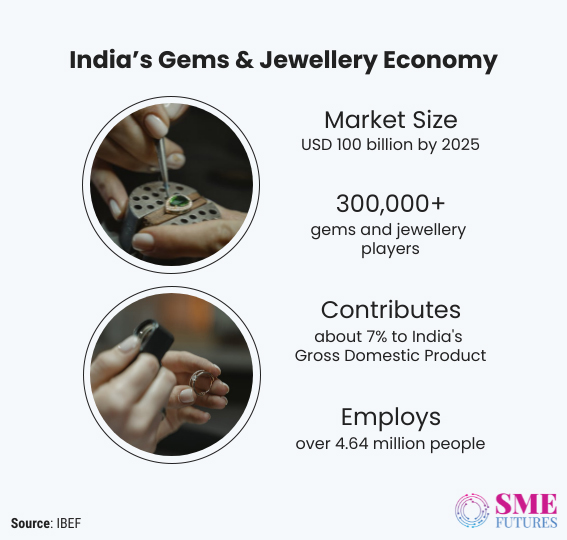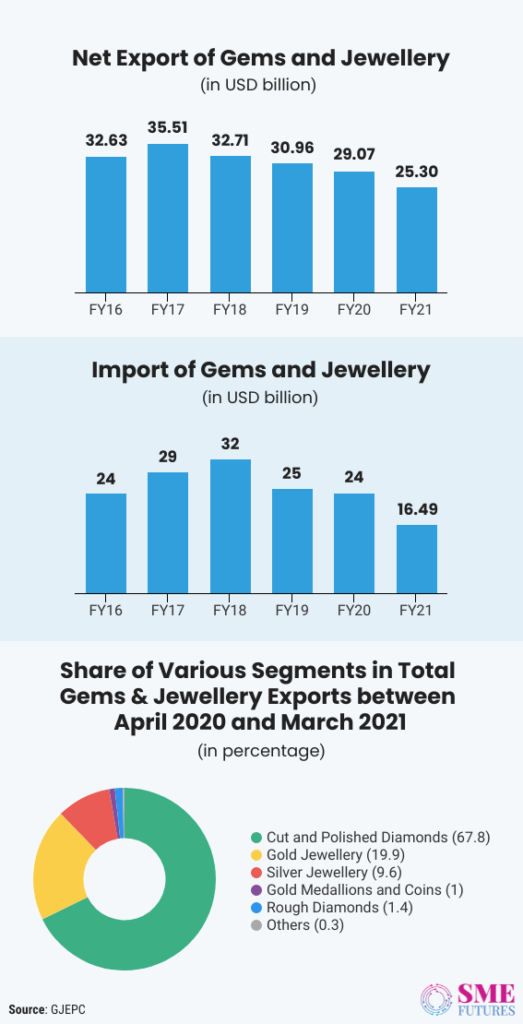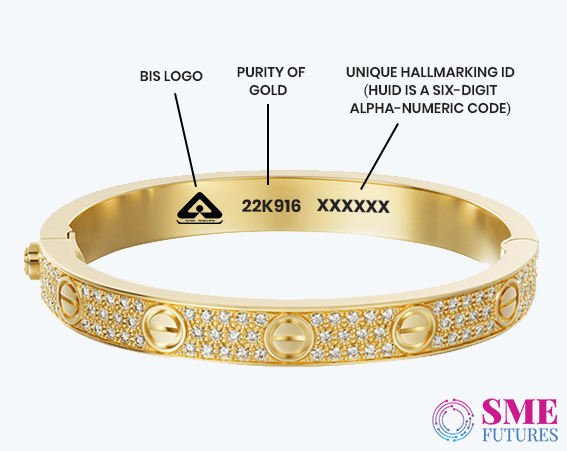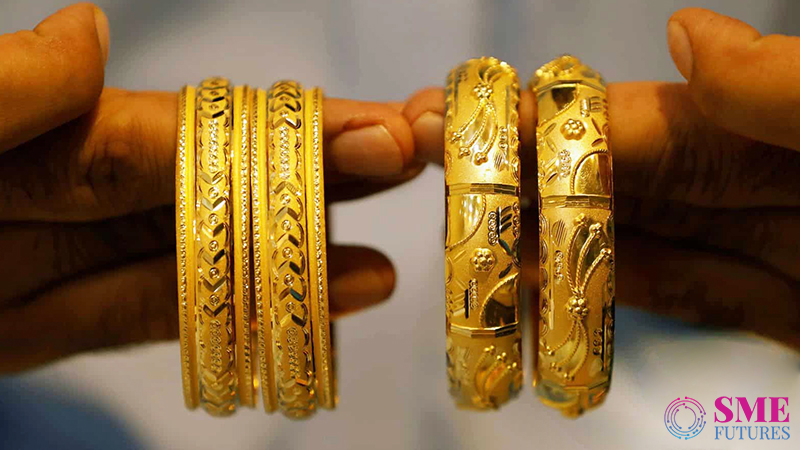When, after numerous postponements, the new gold hallmarking process HUID (Hallmark Unique Identification number) became a mandatory affair, the jewellery community applauded the decision. According to the jewellers, this decision would assuage the customers’ concerns about the purity of the metals, which they hailed as a positive step.
However, lately they have been very vocal about the new hallmarking process. In fact, under the flag of the All-India Gem & Jewellery Domestic Council (GJC), 350 + jewellers’ associations called a nationwide one-day token strike.
So, why is it that the jewellers who not so long ago were welcoming this step, are now so conflicted about it? And how has the new hallmarking system become such a challenge for them? But even before we dive into the heart of the topic, let’s first understand what hallmarking is all about and why the government has been so focused on its implementation.
As an identifier of the purity of metals
Hallmarking is not a new concept; it was already there in the system. For a long time, hallmarking has been used in the jewellery industry to prove that the gold, silver or platinum jewellery or artefact that you are purchasing is genuine.
So, if you have ever noticed the inscriptions on your jewellery, particularly the Bureau of Indian Standards (BIS) logo, it is an indication that it has been hallmarked. It’s a guarantee of the fact that the jewellery or metal artefact that you have purchased is pure and not adulterated.
However, the thing is that it was not mandatory up until recently.
It being a voluntary exercise led most jewellers to simply sell their products unmarked unless a buyer specifically demanded it. As a result, at present only 30 per cent of Indian gold jewellery is hallmarked.
In the past the government had already made several attempts to mandate hallmarking, but none of them came to fruition. But since June, things have changed. With many objectives to achieve, the government has made gold hallmarking mandatory for all jewellery manufacturers.
“The hallmarking of jewellery/artefacts is required to enhance the credibility of gold jewellery and ensure customer satisfaction through third party assurance for the marked purity/fineness of gold and for consumer protection,” reads the government announcement dated 15th June.
As far as transparency and the protection of consumer rights are concerned, it’s a reasonable step.
Another objective is to make India a leading gold market centre in the world.
Currently, India’s gold market stands second to China’s with approximately 800-900 tonnes of annual demand. However, it’s still fragmented due to the large number of unorganised and small players in this market.

The requirements that come with this new rule
So far, the government has identified 256 districts from 28 states and union territories for the phase-1 implementation of gold hallmarking. There are several requirements which the government has mandated in order to implement this phased programme.
First of all, any manufacturer, importer, wholesaler, distributor or retailer engaged in selling precious metal articles has to mandatorily get registered with the BIS. However, artisans or manufacturers who are manufacturing the gold jewellery on a job work basis for the jewellers and are not directly related to its sale to anyone in the chain are exempted from registration.
Also, gold hallmarking is mandatory for gold jewellery and artefacts of 14, 18 and 22 carats. Gold of the additional carats of 20, 23 and 24 will also be eligible for hallmarking. Watches, fountain pens and special types of jewellery such as Kundan, Polki and Jadau are not required to be stamped. Also, jewellers can continue to buy back old gold jewellery without the hallmark from consumers.
They are also allowed to alter hallmarked jewellery by up to 2 grams without going through the whole process again.
The export and re-import policy for jewellery as per the Trade Policy of the Government of India says that jewellery for international exhibitions and jewellery for government approved B2B domestic exhibitions will be exempted from mandatory hallmarking. Even the micro businesses in the jewellery making sector, whose annual turnover is up to 40 lakhs are exempted from compliance to this rule.
Now, in order to follow this mandate, jewellery makers will have to send their inventories to the hallmarking centres to get them certified, where the jewellery will be marked with the following symbols— the BIS logo, the purity in carat and fineness measure(K) and the six-digit alphanumeric HUID (Hallmark Unique Identification number).
But that’s not the problem which is making the jewellers anxious
“It’s the process we are talking about,” says Prakash Kagrecha, a member of the National Task Force on Hallmarking and the President of the Mumbai Wholesale Gold Jewellery Association.
According to him, the jewellers are okay with what the government has drafted as the hallmarking rules. But they are not satisfied with the whole process, its compliance and how the government is tackling it.
“The BIS, far from being a standard and quality assurance institution is playing the role of a revenue department with the gems and jewellery industry becoming a very soft target for them. Jewellers have been waiting for almost 2 months while the complications keep piling up and these impractical laws will result in the collapse of the industry,” says the National Task Force on Hallmarking.
“We have always welcomed hallmarking as it has built our businesses and upped the confidence of our customers, but we cannot accept the new HUID (Hallmarking Unique ID) as it has nothing to do with the purity of gold,”
says Ashok Minawala, Past Chairman – the All-India Gem and Jewellery Domestic Council and a member of the National Task Force on Hallmarking.
“The new HUID is a 6-digit code, which the BIS feels will improve gold purity, but the agency cannot prove even one element of how it can improve purity, apart from it being just a tracking mechanism,” he says while questioning the intent behind this mechanism.
Jewellers are demanding that either they should be given more time by postponing the process or the scheme should be withdrawn altogether. The BIS obviously does not approve of this.
Already proclaiming this scheme to be a grand success, Pramod Kumar Tiwari, Director General, the Bureau of Indian Standards (BIS) said that it made no sense to talk about its postponement or withdrawal.
He reiterated that HUID-based hallmarking was a win-win situation for everyone, as it brings about transparency in the functioning of the industry, ensures the consumers’ right to get the right stuff for their money and obviates the chances of a recurrence of the Inspector Raj.
But jewellery makers are not at all convinced. They already have a list of issues related to the process and we will talk about them going forward.
HUID- a not so friendly process
Jewellery makers have already made it crystal clear that they are not opposed to hallmarking. But they are against HUID, which is the root of the confusion in the sector.
HUID is a six-digit alphanumeric unique code that will be assigned to each piece of jewellery made by a jeweller. This code will help to identify the jeweller as well as the Assaying and Hallmarking Centers (AHCs). The catch is that the jewellers themselves must assign this unique code to their stock, upload the details to the BIS website, and then send it for hallmarking.
Which is more like a clerical burden, opines Vijay Goyal, President, Chamber of Commerce & Industry, Madhya Pradesh.
“Now we have to maintain the data of each piece in our inventory, upload it on the BIS portal and then it will get hallmarked. This whole system will consume the time of the business owners,” he says.
Both the AHCs and the jewellers have to upload the HUID. Since it is a cumbersome, time-consuming process, there is a delay in hallmarking at the AHCs, which is further disrupting the entire supply chain.

It’s a tracking mechanism!
In Minawala’s opinion, HUID is impractical and unimplementable.
“HUID is against customer interest and against the principle of the ease of doing business. HUID is cumbersome and shall lead to harassment for the customers. It is also illegal as per the laws of the land as this process interferes with the data privacy and the business secrecy of individual citizens. Jewellers feel that by registering with the BIS, they have signed their death warrant in terms of losses and the loss of their livelihoods,” he asserts.
Goyal further tells us that he is worried about the requirement of uploading details of sales on the BIS portal. “Suppose we are done with uploading details, and if after some time, the customer comes back to return the jewellery, how is it going to work?” According to him, after filing the details, the jewellers can neither buy back the jewellery nor can they resell it. Eventually they have to melt it, which entails huge losses for them.
Kagrecha also adds in his comments, saying, “The portal system that the BIS has shown us is meant to record everything. Right from the manufacturing process to the end consumer. My question is how are they going to answer this? How will the small jewellers do this on their own, as they don’t have the infrastructure. Now it is more like a clerical duty that the jeweller must focus on instead of doing his main trade—making and selling jewellery.”
However, on the specific issue raised by Goyal and others, BIS claims it is a misunderstanding. Tiwari, the DG of the BIS, clarified in a press briefing that the BIS is not tracking the B2B movement of jewellery and the claim that the jewellers were required to upload the details of their sales on the BIS portal is a misunderstanding. He claims that there is no such requirement on the part of the jewellers.
Less AHCs are making it more daunting
The BIS states that the new process is to be implemented in phases. In the first phase, 256 districts will be covered where AHCs are readily available. In the second phase, those districts will be covered where AHCs are within 100 kilometres. In the last phase, the regions with no AHCs will be covered.
Since the government has mandated the HUID hallmarking process, a growing number of jewellers are registering on the portal. In some ways, this is a good thing.
In order to encourage more registrations, the BIS has waived the registration fee, which was previously required to be paid by the jewellers. According to various sources that we have spoken to in the past, approximately 33,000 jewellers were on the BIS portal, but that number is now over 93,000 and growing.
“This shows the jewellers’ commitment towards their consumers,” says Kagrecha.
But one big concern of the jewellers is the low availability of functional AHCs.
Talking about how this is an issue, Kagrecha tells us, “The number of hallmarking centres is far less than what is needed to do the task. The hallmarking centres have been reduced, as 83 centres have been either suspended or cancelled.”
According to him, in the past there were 1300 AHCs across India, but now the number has been reduced to 800 because of various reasons, one of them being malpractice.
He points out that ever since the government has mandated the HUID hallmarking process, more jewellers are registering on the portal. This clearly implies that now more and more jewellers will generate HUIDs and send in their jewellery or artefact stocks to the hallmarking centres for getting certified. Which means that the currently functioning AHCs are going to be swamped with hallmarking requests.
This means that more discrepancies can occur in the hallmarking process, which in turn will only lead to losses for the jewellery makers.
On this Kagrecha comments, “The DG of the BIS is saying that this is the responsibility of the jeweller. My question is how can the jeweller be held responsible for issues occurring in hallmarking? If an independent party is doing the assaying, then they are testing the ornament.”
But the BIS refutes the claim that the existing capacity of the AHCs in 256 districts is not enough to meet the demand. The agency asserts that 853 AHCs are functioning in the districts. “Out of the 853 AHCs which received jewellery during the fortnight of the 1st to the 15th of August 2021, only 161 got more than 500 pieces per day, and more than 300 AHCs received less than 100 pieces per day. Hence, there was a lot of underutilised capacity in the country,” clarifies the BIS in their statement.
According to the government data, there has been a 25 per cent increase in AHCs in the last five years—from 454 to 945. At present 940 assaying and hallmarking centres are operative. Out of this, 84 AHCs have been setup under the government subsidy scheme in various districts.
Meanwhile, the BIS assures us that the functioning of the AHCs was being reviewed regularly and they have all been instructed to follow the first in, first out (FIFO) principle. A proposal has also been submitted to DoCA for enhancing the reach of the AHCs.

Hallmarking under HUID is time consuming
Stakeholders state that the HUID was supposed to make their jobs easier, but it appears to be a hindrance so far as the AHCs are taking far too much time to do the hallmarking. Currently the new marking system i.e., HUID is taking almost 5 to 10 days to hallmark the products, resulting in a total bottleneck and the industry is at a standstill.
“We told them (BIS) in the first place that HUID is not practical, and you (BIS) should not do it. You (BIS) will land up in trouble. And just look at the scenario, in the last 60 days what has happened…” says Minawala.
What used to take four to six hours to do, is now taking 5 to 20 days, depending on which part of the country you are in. “It’s going to be a troublesome process, and many will lose money,” he opines.
“The gold jewellery market is extremely fluid; the metal’s price fluctuates every minute. Suppose I had to do a jewellery transaction with a dealer at X rate today, and my stock is not yet hallmarked. Now it’s going to take an extra 5 to 20 days, within which time, the gold rates will go haywire. Then it’s going to be a loss-making affair, which in turn will impact the jeweller’s business negatively,” he elaborates.
According to estimates by the national task force for hallmarking, almost 10-12 crore pieces are manufactured in India on a yearly basis. In addition to that, the existing stock is of almost 6 – 7 crore pieces, which are yet to be hallmarked. This takes the total count of pieces to be hallmarked in a year to almost 16 – 18 crore pieces.
Dinesh Jain, Director GJC & GJSCI, who has also been vocal on these hallmarking issues, says, “The current speed or capacity of the hallmarking centres is for about 2 lakh pieces per day but at this speed it will take almost 800 – 900 days or the equivalent of 3 – 4 years to mark this years’ production alone.”
“The wholesalers and manufacturers who generally stock jewellery in thousands are unable to get their jewellery hallmarked as the hallmarking centres under the current procedure of hallmarking are not able to give the required output. The new HUID process being implemented will take weeks or even months to get all the jewellery hallmarked,”
adds another stakeholder, Saiyam Mehra, Vice Chairman at GJC.
In addition to that, the HUID is not fool proof and there have been lots of issues such as a double HUID on the same piece or the same HUID on multiple pieces of jewellery, etc. and these have already been brought to the notice of the BIS. Further, the higher turnaround period of a manufacturer will result in the loss of employment and poor ROI, leading to an increase in the cost of the jewellery for the consumers.
“Tonnes of jewellery is lying idle due to delays in the existing hallmarking process and the BIS is simply adding fire to our anxiety instead of resolving these issues,” comments Jain.
Minawala asserts that the jewellers are demanding a faster paced process. “Earlier, hallmarking only took 4 to 6 hours. We are okay if the AHCs take a few more hours. Give us the hallmarked product in half a day, a day or even two days. But why is it that they are making it such a long ride for us. You (AHCs) cannot take a week or two weeks just to hallmark jewellery. It’s detrimental for the business,” he avers.
He further feels that this issue is not going to end soon, as the number of registered jewellers is surging upwards. “They have not even started hallmarking yet. Imagine what sort of trouble is coming for the players in the field. How is the BIS going to handle all these people,” he asks?
Not a fool proof process
Largely, most jewellers are touting the new system as a ‘destructive process’ that not only damages their jewellery but has also led to the gold market losing its sheen due to its prolonged hallmarking process.
When they say destructive, they mean it literally.
The new hallmarking process (HUID) involves the cutting, melting, and scraping of the jewellery which is intended for sale.
“In the past it was a four-symbol marking system, now it’s a six-symbol marking system. And you know, jewellery pieces are handcrafted. They are very delicate and sometimes quite small. If the BIS is going to put all those markings at once, it will spoil the beauty of the ornament,” Kagrecha tells us.
The entire purpose of hallmarking is defeated when the jewellery gets damaged.
Further, this process eliminates the instant consumer friendly services, which are the biggest USPs of this sector. “The removal of the jeweller’s name from the jewellery will be detrimental to the interests of the consumers when they attempt to either sell or exchange their jewellery for want of the proper identity of the jeweller,” Kagrecha points out.
The hallmarking stamp, the identification mark of the AHC and the jeweller mark will be replaced by the HUID number.
Bringing in the inspector raaj!
The other worrisome aspects of this system are the penal provisions, the cancellations of registrations and the search & seizure procedures.
If any market player is found guilty of not complying with the new rules or gold is sold without the BIS hallmark, the jeweller will be either penalised five times the cost of the product or be sentenced to a one-year imprisonment.
According to the market players, this will ultimately bring back ‘Inspector Raaj’ in the industry.
Commenting on the new rule, Minawala says, “It’s not a question of whether it is too much. It’s a question of justification. A third party i.e., the AHCs are testing and marking these pieces and that too under the norms set by the BIS. Then for any issue in the hallmarking why is the jeweller going to bear the responsibility? Can you hold the jeweller responsible for a problem in the hallmarking standard or the purity of the gold after it has been hallmarked?”
What lies ahead
Finally, mandatory hallmarking is a necessary step. However, the jewellers aren’t very excited about the HUID procedures. Down the line, stakeholders see the implementation of HUID leading to gloom and uncertainty in the industry.
With the festive season just around the corner, the jewellers are especially worried.
Minawala says, “The festive season is around the corner and Maharashtra is the epicentre for starting the season for us with Ganesh Chathurthi. And being the capital of the jewellery industry, we always have high hopes, but the jewellers here are in a dire state due to the current scenario. I cannot imagine the plight of the jewellery makers and what is going to happen to them. As it is taking 15 to 20 days to hallmark their stock. Even taking a hallmarking appointment is another pain which will take at least 10 more days.”
“This delay in hallmarking is affecting our business. We cannot deliver our goods in a timely manner to our customers. What will happen during the festive and marriage seasons if this scenario continues?” Jain of GJC also adds.
Moving on, to avoid or to mitigate these challenges, the Indian jewellers have voiced some strong opinions and have spelt out some clear-cut demands. They propose that hallmarking should be based at the point of sale, while all the other applications of storage, display, transit, exhibit to sale, manufacture etc. except selling should be removed from the BIS Act and Regulations.
It’s not only the consumers who will be at the receiving end, but the 1 crore people who depend on the G&J Industry for their livelihoods will also suffer immensely due to the unimplementable and impractical compliances in this new hallmarking process (HUID).
The penal & criminal consequences to the jeweller, who has not manufactured or hallmarked the jewellery and has only sold it like a trader, will eventually result in the winding up of businesses in fear of the ‘Inspector Raaj’ which has already begun. The draconian provision of the cancellation of registration for a civil offense, just by the stroke of a pen from a BIS officer, will result in the loss of the livelihoods of millions of employees, karigars and their dependents.
Jewellers are demanding that the BIS do their homework first, before putting in place a system for the jewellery industry. As it’s one of the growth sectors of the Indian economy. Any loose end might hurt this sector badly, especially when it is still recovering from the devastating aftermath of the pandemic.










